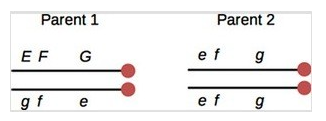Sodium dodecyl sulfate (SDS) and Triton X-100 are both detergents that can be used to lyse cells
A. If the goal is to study the activity of membrane proteins after cell lysis, explain why SDS would not be a good choice.
B. How does Triton X-100 work in cell lysis, and why is it a better choice of detergent to help you extract proteins?
A. SDS is a strong ionic detergent. When cells are exposed to SDS, membrane proteins are not only extracted from the membrane, they are completely unfolded. After denaturation, they cannot be studied as functional molecules.
B. Triton X-100 has a smaller nonpolar portion and a polar but uncharged end, allowing it to mimic more closely the type of solvation effect of the membrane lipids. Triton X-100 forms a shell around the hydrophobic portion of the protein without disrupting the existing structure. This makes it possible to then place the protein into a new, synthetic membrane bilayer for study.
You might also like to view...
Ocean acidification is being caused by
a. global warming. b. nitrogen fertilizer runoff. c. phosphorous fertilizer runoff. d. transfer of carbon dioxide from atmosphere to ocean. e. transfer of carbon dioxide from ocean to atmosphere.
In plants, genes E, F, and G are on one chromosome arm. Alternate dominant and recessive alleles of all three genes determine visible traits: E = normal leaf number, e = extra leaves, F = normal stems, f = furry stems, G = normal flower size, g = gigantic flowers. A plant that is heterozygous for an inversion involving all three genes is crossed to a plant with extra leaves, furry stems, and gigantic flowers. The arrangement of alleles is shown in the diagram. If you look at thousands of offspring of this cross, what phenotypes do you expect to see?(Select all that apply.)

A) Most, but not all, offspring will be normal for all three traits or have extra leaves, furry stems, and gigantic flowers.
B) Due to double crossovers between E and F and F and G, a very small number of offspring will have only furry stems, or only extra leaves and gigantic flowers.
C) Half of the offspring will be normal for all three traits and half will have extra leaves, furry stems, and gigantic flowers.
D) Due to crossovers between E and F in parent 1, a small number of offspring will have only extra leaves, or only furry stems and gigantic flower size.
E) Due to crossovers between F and G, a small number of offspring will have only extra leaves and furry stems, or only gigantic flower size.
In eusocial animals like ants, the queen is diploid and the male is haploid. Why would female worker ants be more likely than other animals to engage in altruism, feeding the queen's offspring?
A. The queen establishes a dominance hierarchy over the colony. B. The worker ants are monogamous and remain faithful to the queen ant. C. It is a reflex for the worker ants to be altruistic. D. The worker ants are more related to the queen's offspring than they would be to their own offspring. E. The worker ants hope for reciprocal altruism and may become the queen ant.
How does rhodopsin facilitate vision?
a. When light strikes rhodopsin, the bipolar cells becomes depolarized, causing the release of GABA. b. When light strikes rhodopsin, the photoreceptor becomes depolarized, causing the release of GABA. c. When light strikes rhodopsin, the photoreceptor becomes hyperpolarized, causing the release of GABA. d. When light strikes rhodopsin, the photoreceptor becomes depolarized, causing the release of glutamate. e. When light strikes rhodopsin, the photoreceptor becomes hyperpolarized, causing the release of glutamate.